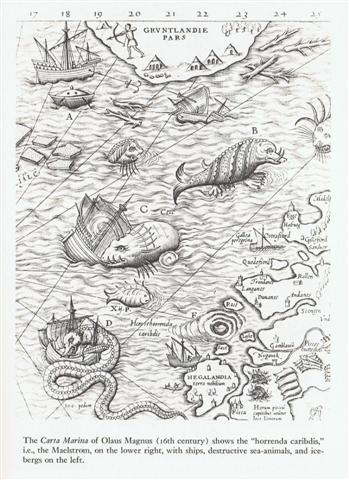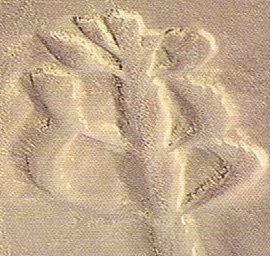|
TRANSLATIONS
Far up in the north there is a whirlpool in the sea which drags ships down:
I have copied the picture from Hamlet's Mill, which in turn has copied it from Carta Marina (Olaus Magnus), and we see the Maelstrom ('horrenda caribdis'), the whirpool, at lower right (F). The sky is turning around but there are two spots, one in the extreme north and one in the extreme south, where there must be a center around which the whole sky dome moves. When water turns churning around we can always find a depression in the surface at the central spot. If the water turns quickly, then the central spot goes down and a spiral around will suck floating stuff (like ships) down - as if swallowing. From Hamlet's Mill I also think it is time to fetch this piece to our puzzle: "There is a mill which grinds by itself, swings of itself, and scatters the dust a hundred versts away. And there is a golden pole with a golden cage on top which is also the Nail of the North. And there is a very wise tomcat which climbs up and down this pole. When he climbs down, he sings songs; and when he climbs up he tells tales. Tale of the Ostyaks of the Irtysh." The 'tomcat', we can now guess, must be the sun and the 'mill' the turning sky dome. The 'mill' is a way of describing why the sky dome is rotating. From the 'tomcat' we perhaps can better understand Mafdet:
Perhaps also the Candelabra (with birds flying above and two catlike creatures climbing at right):
Maybe even the variant of GD52 with a 'tree':
Up in the north there is a great gap swallowing everything, the place of 'exit'. This place (outside Norway on the west coast) is not, however, located at the same spot as the 'Nail of the North'. Therefore Alphard is chosen to symbolize the place of 'exit' rather than Polaris. Ana-heu-heu-po, the pillar where debates were held - what kind of debates?
From the several meanings of the word heu I get the impression that at the center (of meaning) lies the concept of 'difference'. At the eaves of a house the roof is ending. To pull asunder, separate, to have a mixed descent. To debate, i.e. discuss differences of opinion. Metoro (we remember) used the word heu at what looks like the X-area (Ca5-16 and preceding glyphs):
The 'whirlpool' is the end, the 'mouth of Mundo'. There are 13 'feathers' on Ca5-16. The old year evidently 'goes down' at Alphard (a name which is strangely similar to the letter of beginning, alfa). Ana-heu-heu-po has po there at its end probably to indicate the 'black cloth'. The creators of Manuscript E were a few old men living in the leper colony on Easter Island. Curiously Alphard, alfa and leper colonies are concepts quite closely related to each other: "Coleridge's mention of leprosy [in his Ancient Mariner] is strangly exact. The whiteness of the Goddess has always been an ambivalent concept. In one sense it is the pleasant whiteness of pearl-barley, or a woman's body, or milk, or unsmutched snow; in another it is the horrifying whiteness of a corpse, or a spectre, or leprosy. Thus in Leviticus XIV, 10, the leper's thankoffering after his cure, originally paid to the Goddess Mother, was a measure of barley flour. Alphito, it has been been shown, combined these senses: for alphos is white leprosy, the vitiliginous sort which attacks the face, and alphiton is barley, and Alphito lived on the cliff tops of Nonacris in perpetual snow. Pausanias connects leprosy, the meaning of which is 'scaliness', a characteristic of true leprosy, with the town of Lepreus, which lay close to the river Alpheus in the district of Triphylia ('trefoil'), which was a leper-colony founded by a goddess called Leprea: it afterwards came under the protection of 'Zeus of the White Poplar', for another name for leprosy is leuce, which also means 'the white poplar' ..." (The White Goddess) The White Goddess means the Moon. At new moon the moon is invisible, swallowed by darkness. We must remember to include the moon in our analysis. '... The correspondence between the winter solstice and the kali'i rite of the Makahiki is arrived at as follows: ideally, the second ceremony of 'breaking the coconut', when the priests assemble at the temple to spot the rising of the Pleiades, coincides with the full moon (Hua tapu) of the twelfth lunar month (Welehu) ...' Furthermore, the moon determines - terminates - by the pregnancy period (9 * 28) the sun year. There is not just one place for 'swallows':
|
|||||||||||||||||||||||||||||||||||||||||||||||||||||||||||||




